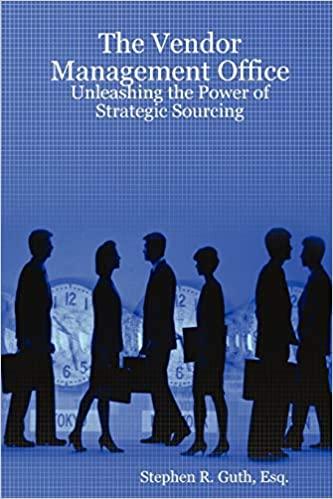Answered step by step
Verified Expert Solution
Question
1 Approved Answer
1. (TCO 1) In a traditionally structured organization, the plans and goals that affect the entire organization are made by _____________ (Points : 7) First
1. (TCO 1) In a traditionally structured organization, the plans and goals that affect the entire organization are made by _____________ (Points : 7) First Line Managers Top Managers Middle Managers Supervisors 2. (TCO 2) The process of actively monitoring the environment through activities such as reading and observation is called (Points : 7) being socially responsible. environmental scanning. alliance creation. informational management. a strategic response. 3. (TCO 3) _____ is when an organization's intention is to go beyond its legal and economic obligations, to do the right thing, and act in ways that are good for society. (Points : 7) Classic view Sustainability Social responsibility ISO 9000 All of the above 4. (TCO 4) The European Union and North American Free Trade Agreement are often in the news in the United States. There are other trade agreements in the world. China and South Korea are not members of a specific trade agreement, but do take part in trade discussion of which agreement or association? (Points : 7) South Asian Association for Regional Cooperation Association of Southeast Asian Nations East Asia Trade Community Asia United Trade Agreement None of the above 5. (TCO 5) Manger must be focused on the future. ______________ are targets that managers are trying to reach and they are also the basis by which work results are measured. (Points : 7) Performance Time-frames Objectives Environmental Scanning 6. (TCO 6) Jay wants to start a new business. Which of the following questions should he use as part of his analysis of the ideas for a new business? (Points : 7) Who is the potential customer? What similar or unique product features does his proposed idea have to compare to what is currently on the market? How and where will potential customers purchase his product? How will he need to promote and advertise his product? All of the above 7. (TCO 7) _____ is defined as the number of different tasks required in a job and the frequency with which the tasks are repeated. (Points : 7) Job enlargement Job enrichment Work teams Job specialization Job scope 8. (TCO 8) The job characteristics model is a framework for analyzing and designing jobs that identifies five primary core job dimensions, their relationships, and their impact on employee productivity, ________, and satisfaction. (Points : 7) Autonomy Task alignment Motivation Feedback 9. (TCO 9) During which stage of group development do members try out various forms of behavior in an attempt to "test the waters" and see what will be acceptable in the group? (Points : 7) Norming Storming Forming Performing Conforming 10. (TCO 10) Income statements, balance sheets, and audits are examples of the control of (Points : 7) physical resources. cybernetics. financial resources. organizational complexity. human resources. Short Answer Questions 1. (TCO 2) An organization's external environment refers to forces outside the organization that affect its performance. Compare and contrast two of the components of the external environment. 2. (TCO 3) Encouraging ethical behavior is part of management's role. What are four things that an organization's management can do to encourage ethical behavior? Give examples for each thing a company can do. (Points : 10) 3. (TCO 8) Identify three performance appraisal methods and an advantage and disadvantage of each method. 4. (TCO 9) Explain how workplace design can influence communication in an organization. A Chapter 16 (Points : 10) 5. (TCO 10) What is controlling and why is it important to an organization? (Points : 10) 6. (TCO 1) Recall a recent group project or task in which you have participated. Explain how members of the group displayed each of the managerial skills. (Points : 10) Essay Questions 1. (TCO 2) Planning seems to take a lot of effort. Why is it so important for managers to plan? List four main reasons and explain each in detail. Share an example. (Points : 20) 2. (TCO 9) Describe in detail the three major contingency theories of leadership. How do these differ? (Points : 20) 3. (TCO 10) Explain what a PERT network system is and share an example of when it would be best to use this tool. (Points : 20)
Step by Step Solution
There are 3 Steps involved in it
Step: 1

Get Instant Access to Expert-Tailored Solutions
See step-by-step solutions with expert insights and AI powered tools for academic success
Step: 2

Step: 3

Ace Your Homework with AI
Get the answers you need in no time with our AI-driven, step-by-step assistance
Get Started


